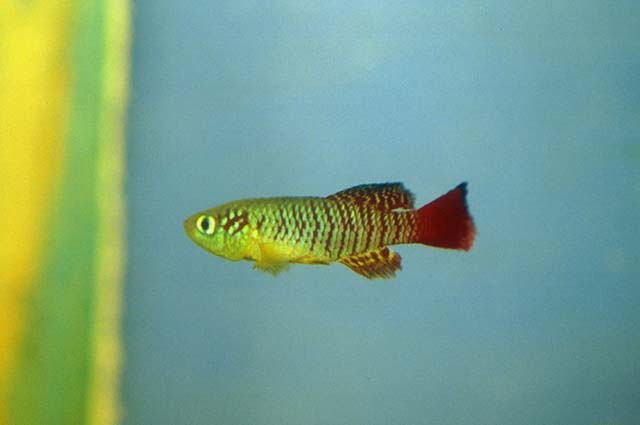|
Dorsal spines (total): 0-0; Dorsal soft rays (total): 15-16; Anal spines: 0-0; Anal soft rays: 15-16; Vertebrae: 28-28. Diagnosis: It is distinguished from all congeners by the combination of the following character states: caudal fin red with black posterior margin in males; flank and fins without dark spots in females; pre-dorsal length in males 57.5-61.4% of standard length; 3 + 12-14 gill-rakers on first branchial arch; 27-28 scales in longitudinal series; 14 series of scales around caudal peduncle; single longitudinal row of scales between anterior supraorbital series of neuromasts; anterior supraorbital series of neuromasts arranged in two sections, anterior section with one well-developed neuromast, posterior with two; three neuromasts in posterior supraorbital series; 26-27 caudal-fin rays; 28 vertebrae; second proximal radial of dorsal fin between neural spines of 10th and 12th vertebrae (Ref. 122075).
Description: Dorsal and ventral profiles slightly convex from snout to posterior end of dorsal- and anal-fin bases, nearly straight on caudal peduncle; body moderately deep, compressed; greatest body depth at vertical just behind pectoral-fin base (Ref. 122075). Jaws short, snout weakly pointed in lateral view; mouth superior, lower jaw slightly anterior to upper jaw; jaw teeth canine, numerous, irregularly arranged; outer teeth greater than internal teeth; vomerine teeth 7-9 (Ref. 122075). Branchiostegal rays 6; gillrakers of first branchial arch 3 + 12-14 (Ref. 122075). Basihyal sub-triangular, greatest width about 65% of length; basihyal cartilage about 85% of total length of basihyal (Ref. 122075). Dorsal and anal fins broad in males, sub-rectangular, extremity rounded, with short filamentous rays along distal margin; in females, dorsal fin rounded, anal fin sub-triangular and slightly longer than dorsal fin; caudal fin subtruncate, posterior margin slightly convex; pectoral fin sub-elliptical, posterior extremity between pelvic-fin base and anus; pelvic fin small, tip reaching between anus and anal-fin origin in males, reaching anus in females; pelvic-fin bases medially in close proximity; in males, rows of well-developed papillate contact organs along two-thirds of most rays of anal fin; dorsal-fin origin on vertical through anal-fin origin or slightly in front of it; dorsal-fin rays 15-16; anal-fin rays 15-16; caudal-fin rays 26-28; pectoral-fin rays 18-19; pelvic-fin rays 6 (Ref. 122075). Scales small, cycloid; body and head entirely scaled, except ventral surface of head; minute filamentous contact organs along posterior margin of scales on middle portion of flank and latero-ventral portion of head in males; body squamation extending over anterior 25% of caudal-fin base; no scales on dorsal- and anal-fin bases; frontal squamation irregularly arranged, with single longitudinal row between anterior supraorbital neuromast series; longitudinal series of scales 27-28; transverse series of scales 9; scale rows around caudal peduncle 14 (Ref. 122075). Anterior supraorbital series of neuromasts arranged in two sections, each in shallow depression, anterior section with one neuromast, posterior one with two neuromasts; posterior supraorbital series with three neuromasts placed in shallow depression; infraorbital series with 13-18 neuromasts, pre-opercular series 11-14, mandibular 8-13; one neuromast per scale of lateral line; two neuromasts on caudal-fin base (Ref. 12275). Total vertebrae 28; second proximal radial of dorsal fin between neural spines of 1Oth and 12th vertebrae in both sexes; first proximal radial of anal fin between pleural ribs of 11th and 13th vertebrae in males, between pleural ribs of 10th and 11th vertebrae in females; ventral process of post-temporal rudimentary or absent; hypurals completely fused, forming single hypural plate without vestige of median gap (Ref. 122075).
Colouration: Colouration in life for males: flank light greenish blue anteriorly to light blue almost white; posterior margin of scales red to form red reticulate pattern, often inconspicuous in anterior portion of flank, gradually more pigmented posteriorly; red bars overlapping red reticulum between flank zone near pelvic fin and posterior part of caudal peduncle, anterior bars slightly curved, posterior bars approximately straight; dorsum pale brown, venter white; side of head light greenish blue; jaws, dorsal and ventral parts of head pale yellow; red pigmentation forming reticulate pattern on post-orbital region, overlapped by three distinctive oblique, short red bars; iris light blue; dorsal fin light blue, with red dots, vermiculate marks and short bars irregularly arranged; black pigmentation concentrated on distal portion of fin; distal filaments white; anal fin pale greenish or orangish yellow, basal portion bluish white, with red dots, vermiculate marks and short bars irregularly arranged; distal filaments pale yellow; caudal fin dense vivid red, posterior margin black; pectoral fin yellowish hyaline, with bluish white distal margin, wider dorsally; pelvic fin pale yellow or red with yellow distal portion (Ref. 122075). Colouration in life for females: flank pale brown, posterior border of scales pale greenish blue; dorsum pale brown, venter white; head pale brown, opercular region pale greenish blue; iris bluish white; fins hyaline (Ref. 122075). |
